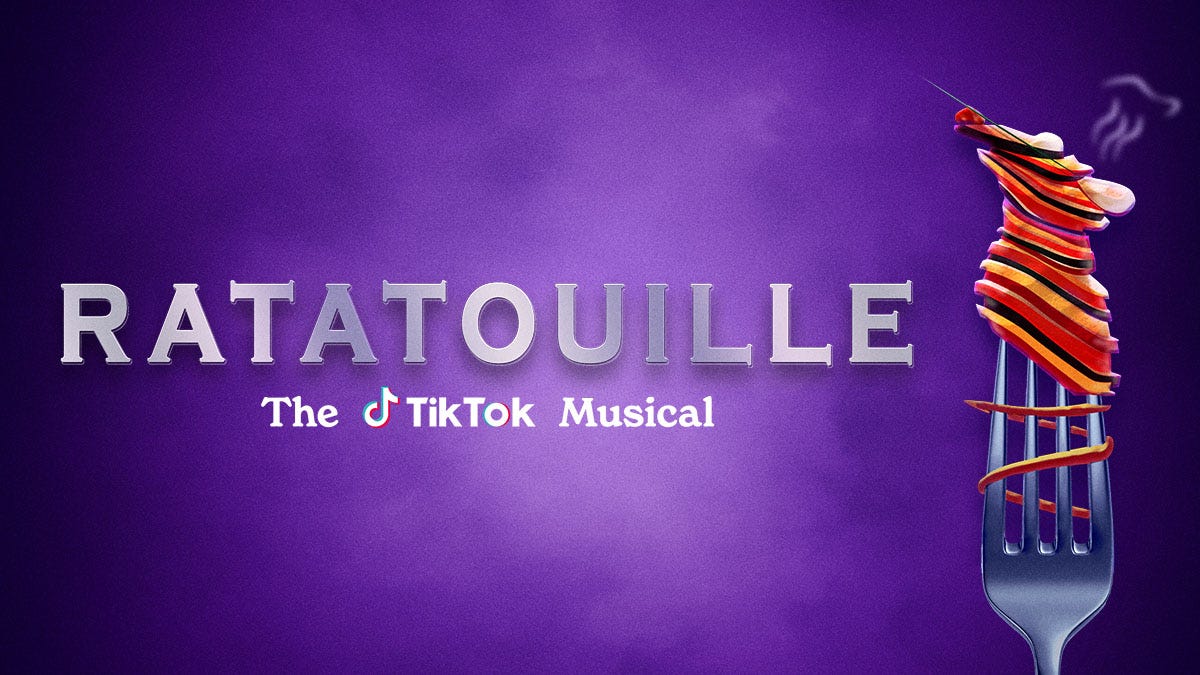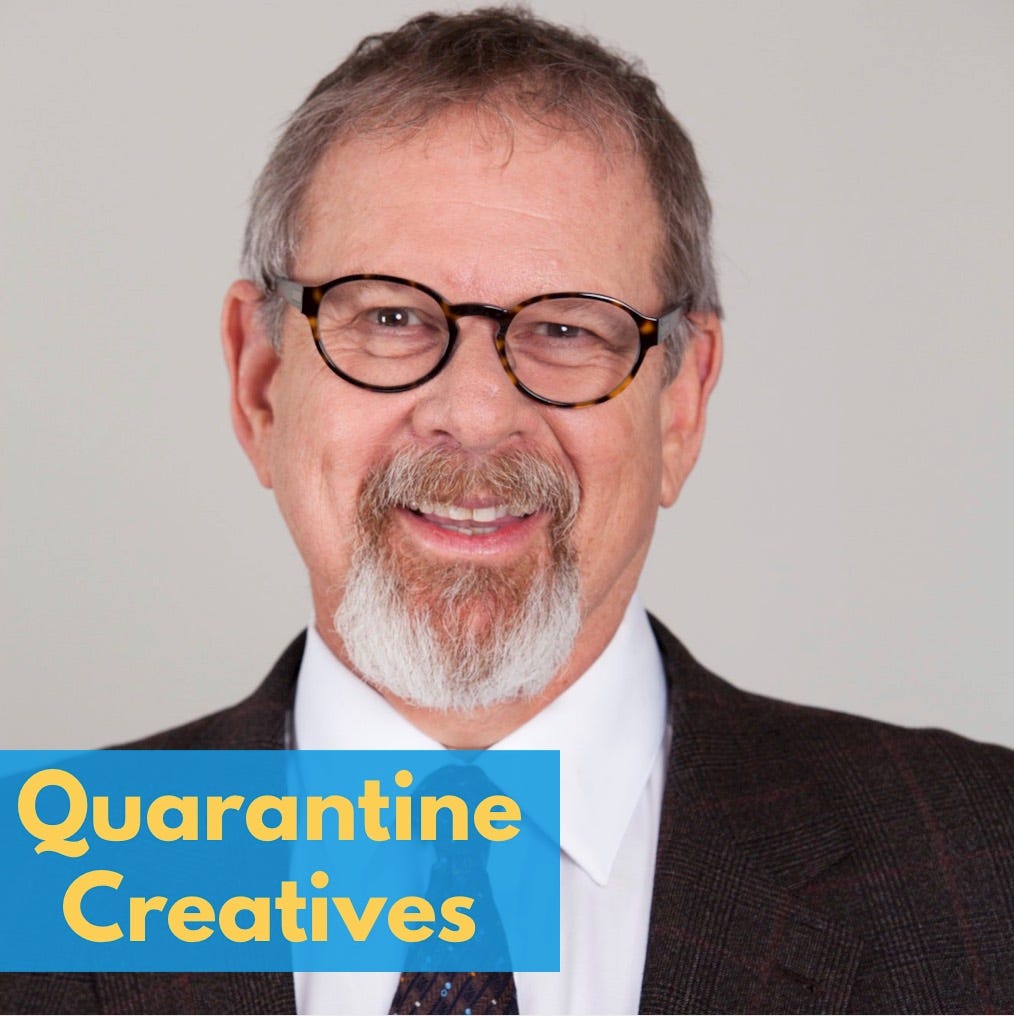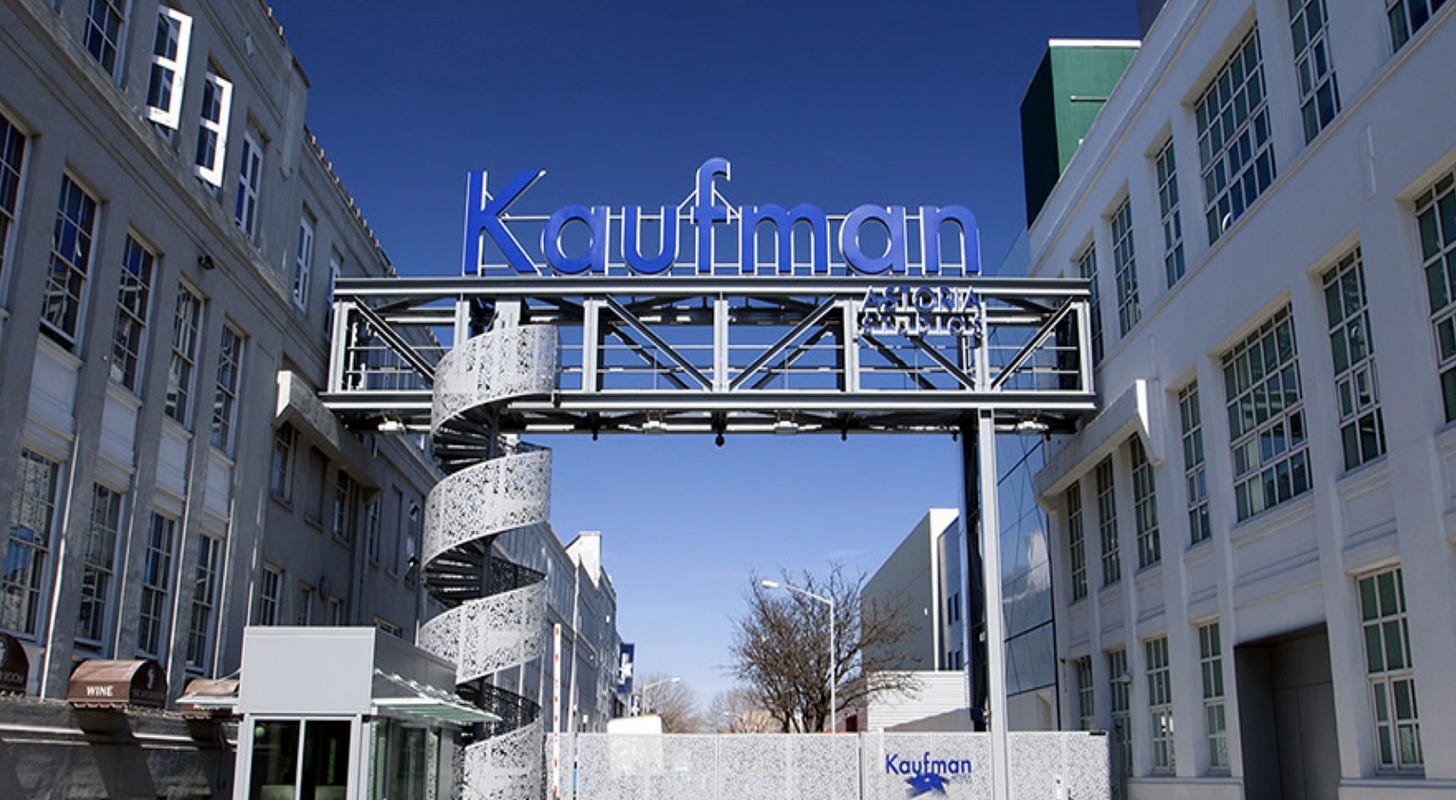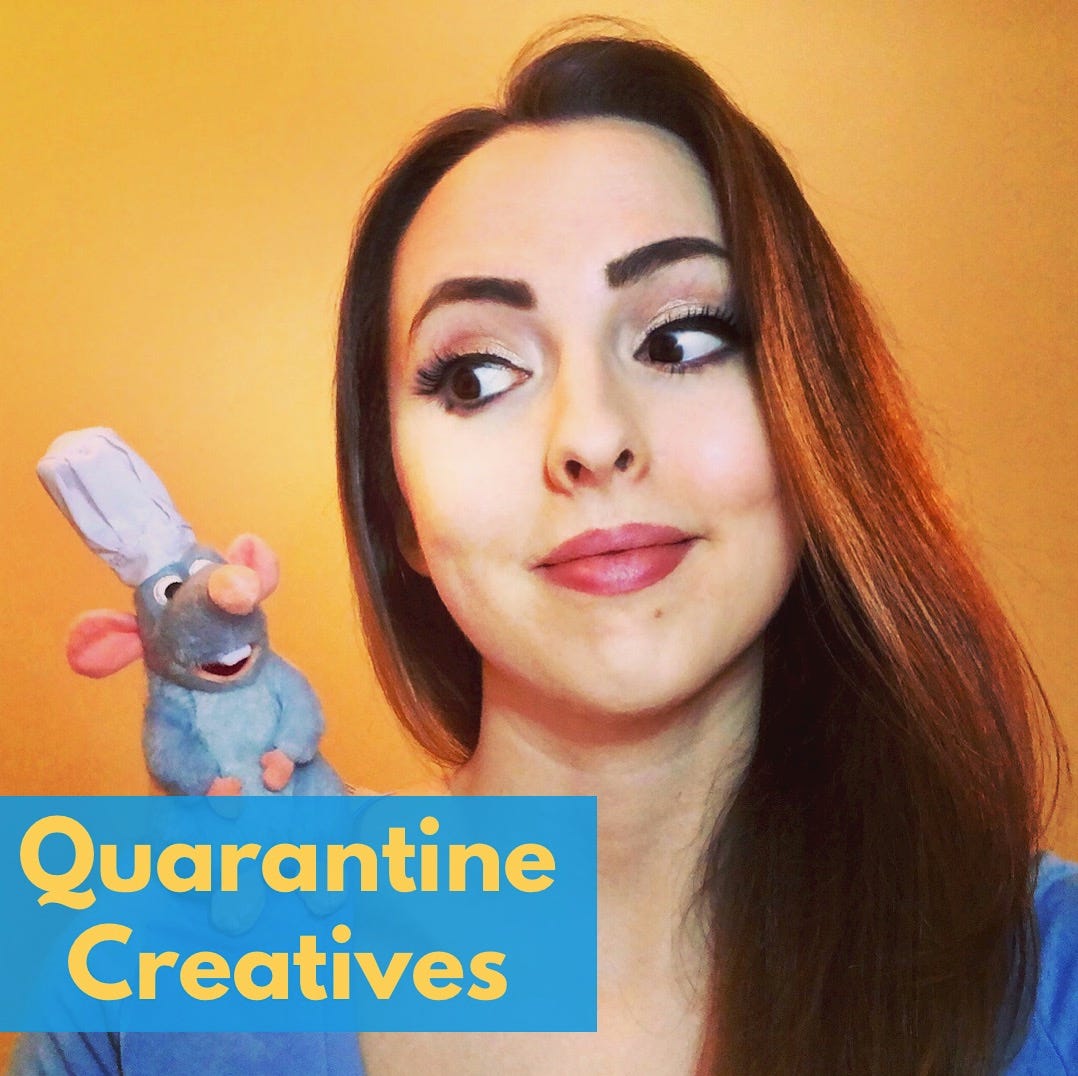Welcome to the Quarantine Creatives newsletter, a companion to my podcast of the same name. This newsletter is delivered to inboxes every Sunday and provides insight from folks across the TV, film, radio, theatre, and media industries. If you like what you read, please add your email for a free subscription:
Live Theatre Returns! (Sort Of…)
Happy New Year! While 2020 brought many challenges to all of us, including me, I sit here at the beginning of this year feeling strangely grateful for the past one. 2020 was a time of immense personal growth and change for me. I have had the wonderful opportunity to spend more time with my children and really watch them grow each day. I have found renewed love for my home, my wife, and my extended family.
Of course, the biggest change in my life has been the launching of this podcast and newsletter. It has been such a thrill to talk to people from all across the entertainment and media industries and to hear their individual stories about the impacts of COVID-19. Some of the hardest guests to speak to are those from the theatre community. Broadway and the rest of live theatre remains dark, with a return not predicted until June at the earliest.
Perhaps the one bright spot in all of this premiered this weekend, Ratatouille: The TikTok Musical. Before the debut, I interviewed Emily Jacobsen, who helped launch this whole movement (more below). It started with a short video that she uploaded to the video sharing app TikTok over the summer about Remy, the rat star of the Disney-Pixar film Ratatouille. That inspired other creators on the platform to create their own songs, sets, choreography, and costumes, until before long, you could get a sense of what a crowd-sourced version of a Ratatouille musical might look like just by browsing TikTok.
Before long, the production company Seaview got involved and a livestream concert to benefit The Actors Fund was just performed on Friday, which takes the essence of the original TikTok songs, adds more lyrics, and even a full orchestration. The show stars veteran performers like Tituss Burgess, Andrew Barth Feldman, Kevin Chamberlin, Wayne Brady, Adam Lambert, Ashley Park, and André De Shields, among others. My wife and I joined in on the fun from our iPad and it was really enjoyable!
Even though the show was performed with the cast in remote locations, it had all the excitement of a live Broadway show, while also paying homage to TikTok stylistically. If you’re a live theatre fan, I highly recommend checking it out. The livestream is accessible on TodayTix through Monday with a donation, which can be as little as five dollars. In my opinion, it’s worth every penny, and supports a good cause too!
Scroll down to read more from my interview with Emily. First, though, some insights into the production scene in New York…
Episode 64- Hal Rosenbluth
Kaufman Astoria Studios in Queens, NY has the distinction of being New York City’s oldest production studio, celebrating 100 years this year. Hal Rosenbluth is the President and CEO of the studio, and we had a really interesting conversation on Monday that looked at some of the larger forces shaping where productions shoot these days.
We started by discussing some of the COVID protocols that are now in place that have allowed production to resume at Kaufman. Hal and his team made many improvements to the physical space that included changing all public bathroom faucets to hands free and adding hand washing stations to every stage. He also discussed the testing and zoning procedures:
“The protocols that are in place to keep everyone safe and healthy are as stringent as you will find anywhere in our industry. My team is tested weekly. On a production company, the base crew is tested weekly. The shooting crew is tested three to five times a week. People are zoned out and separated. It gets compartmentalized so God forbid if there was a breakout, it’s containable.”
The production scene in New York has been surging in recent years, which the New York Times recently spotlighted. While some of this is undoubtedly due to an increase in original programming by networks and streamers, production companies don’t have to make that content in New York.
In recent years, cities and states have been competing for production business by offering generous tax credits. New York State offers a 25% tax credit (with an additional 10% credit for labor costs on productions with budgets over $500,000 that shoot in certain counties Upstate).
Hal sees these tax credits as very beneficial to bringing productions into New York that don’t have to shoot there. He also believes the film industry offers good paying jobs that cycle money back into the economy. He observed that people do not always realize the scale of many productions:
“I asked a producer on one show that was here, ‘on average, how many paychecks are you writing in a week?’ She said over 400. I have walked through politicians in these facilities who are at the highest level who walk around stunned, amazed, because their vision of making a movie is a star and 10 or 20 people.”
When tax incentives first became a big part of the film industry, New York saw many productions move to markets with lower operating costs that became even more attractive with new tax rebates. This led to a slowdown in the New York production industry, which convinced the state to implement a new tax policy that favored productions. While tax incentives can be politically charged, Hal explained when he thinks they can be important, regardless of the type of industry:
“If you have an industry where you have an infrastructure, you have skilled labor, that is losing the work for reasons beyond their control is when you step in to do stuff. We had basically a fairly decent industry, and then it’s disappearing because the costs are so much higher. These weren't the costs that the infrastructure or the skilled labor created, these were just comparisons because other parts of the country it was less costly or other parts of the world it was less costly. So to me, tax incentives need to be put in place to save an industry. You need to save that skilled labor. If you don’t save the skilled labor, then the next generation isn’t going to learn anything, you’re going to lose the skill. That’s how you save an industry and you give it the foundation in which it can grow.”
In Hal’s experience, tax incentives directly benefit production companies, but they can lead others in and around the industry to invest new capital:
“The incentive convinces Netflix, Lionsgate, Warner Brothers, Sony, Amazon, etc to come and spend their money in New York. And they’re the guys getting the tax credit. And it incentivizes because businesses want to build and develop to be able to respond to the marketplace, gets folks like Kaufman, and my competitors, to invest private capital to grow the infrastructure. So every one of my competitors has grown their capacity in the lighting and grip departments. Every one of my competitors have built additional stages. We just opened a new 150,000 square foot building.”
All of this begs the question of whether tax incentives are worth the cost to the state:
“We have data since 2004 that shows a positive return to both the state and the city on these tax credits. So now we have an industry that, depends on your study, is a nine to twelve billion dollar industry in the state of New York, employs direct and indirect over 100,000 people, and has been an ability to diversify the economy in New York, and as such has become one of the pillars of the economy in New York.”
Towards the end of the interview, Hal and I discussed Kaufman’s storied history dating back 100 years. There was a time when the studios had been abandoned and boarded up, and they were a blight on the neighborhood. Hal shared that when George Kaufman bought the studio, he believed that by investing in revitalization he could encourage other development in the neighborhood. Today, the studio is one piece of the Kaufman Arts District, which also includes a performing arts high school, the Museum of Moving Image, a theatre, and restaurants. It’s a remarkable success story, and I encourage you to listen to the full interview to hear about all of the changes.
Episode 65- Emily Jacobsen
Emily Jacobsen, a teacher from New York, is now known as the “Rat Queen” for inspiring the movement that became Ratatouille: The TikTok Musical. I interviewed her on Thursday, before the musical began streaming about the whirlwind that her life has become over the last few months.
Back in March, when the pandemic started, Emily was a Broadway and Disney fan who suddenly found herself locked at home. Looking for ways to pass the time, she started exploring the video based social media app TikTok:
“I was a teacher working from home during when everything started in March. I kind of I think was experiencing a lot of what other people were experiencing where I’m hitting every social media platform and being told ‘that’s it, you’re up to date.’ What else do we do now? So I downloaded TikTok really just as a means to get a laugh, get some entertainment, and never had any intention of posting any videos.”
After dabbling in making videos for TikTok about her cat and some obscure Disney World references, she uploaded a simple video (above) about Remy the rat after reading about a new Ratatouille ride that was under construction for the Epcot theme park in Florida. Her goal was never to go viral:
“I just was singing this around my apartment for fun, thought it was funny and catchy, and just sent it off to family and friends as a joke. I knew it was out there on TikTok, but I didn’t have any followers, I wasn’t trying to create a musical, and it just kind of blew up. And it took two months for it to blow up. I’d forgotten about it. I’d posted it in August, I didn’t have the notification floodgates open until mid-October. And it was crazy.”
Since the musical idea started taking off, and especially since it was announced that the TikTok trend would be turned into a fully staged musical, Emily’s life has really changed. She and her fellow co-creators, have been interviewed by media from all over the world. She described her new reality to me:
“I’m living in an eternal dream. I wake up in the morning and I check different things on social media like oh, did this really happen yesterday or did I really see this here? It’s been fun. With some of the original creators, we have an Instagram group chat we call the Rat Pack. We share things back and forth that we’ve seen, and it’s just so nice to have this little community to get excited about. I’ve made these great friends from TikTok I never would have met otherwise.”
The media opportunities for Emily have not only been limited to interviews from home. Disney invited Emily to tour the construction site of Remy’s Ratatouille Adventure at Epcot last month. It was pretty wild to see her posting fan videos about Disney to her TikTok over the summer and fall, and then a few months later to see her appearing on their official social media accounts as part of their efforts to promote the ride, which is scheduled to open this year.
“I remember the first call I got from Disney, just seeing on my phone Walt Disney World is calling me and since then, I’ve met with the folks at Disney, spoken to them quite a bit on the phone, on Zoom. This is just the opportunity of a lifetime to go backstage and tour this attraction, and engage with them in so many different ways in just a single afternoon. Disney has been so supportive and wonderful. I’m so grateful for what they’ve done for me and for the opportunities that this little song has opened up for me. Again, I’m living in a dream and I am kind of sad to return to post Ratatouille the Musical life.”
I confess to only having recently downloaded TikTok myself, and I have just started to explore the camera and editing functions the app offers. I have been impressed with the tools available to creators that give semi-professional results without needing special lighting, cameras, or editing software. This includes very easy “chroma key” functionality without needing a green or blue screen, creative filters, and intuitive editing controls. Access to these tools have allowed creators of all ages to make really compelling video content. I asked Emily what she likes about TikTok as a creator:
“I think it gives the average, everyday person a chance to create something really incredible. It’s all these tools. I mean, TikTok is free. If you have a phone, if you have internet, just download it, go for it. If things don't go well, you can take it down, no harm no foul.”
At the time we spoke, Emily had not yet told any of her coworkers or students about her connection to Ratatouille: The TikTok Musical. It brought up an interesting discussion about how much authority an employer should have over what an employee does in his or her free time, even if those activities are very public:
“I really have had a lot of concerns about this too. That’s why I don’t actually use my real name on TikTok, and early on, when I was giving interviews, I didn’t give my real name. I stuck to my TikTok name, Em Jaccs, kind of as a way to protect myself really from any repercussions from work. I think it’s a lot of personal responsibility too just to make sure those worlds are not colliding. None of this excitement has interfered with my job. I’ve been at work completing everything I need to do without any kind of delay or problem. I kind of leave all this fun, TikTok, Ratatouille business for afternoons and evenings. I think as long as it doesn’t interfere with the position, it’s your personal life. I would hope that the personal life-work life balance, as long as it’s respected by the individual, should be respected by the job as well.”
Since the musical started streaming on Friday, it has raised more than one million dollars to benefit The Actors Fund. The stream will only be available until Monday through TodayTix and can be viewed with a donation as small as five dollars (it’s suggested to pay what you are able to). It is really a bright spot in an otherwise bleak year for theatre.
What’s Coming…
On Monday, I have an incredible conversation with Maureen McCormick. She is most famous for playing Marcia Brady on The Brady Bunch, but has been involved with HGTV since participating in A Very Brady Renovation in 2019. It turns out that home building and renovating have been in her blood from an early age. Her new renovation series Frozen in Time premieres on Monday as part of the new streaming service Discovery+. We talk about old houses and antiques, plus her relationship to Marcia.
On Thursday, I will be speaking with Craig D’Entrone, who is the show runner for the huge PBS project American Portrait, which includes a broadcast series that premieres this Tuesday at 9pm on PBS. The four part docuseries was all self-taped by the documentary subjects and helps answer the question of what it means to be an American right now. Craig and I discuss their innovative production techniques, plus his background producing the MTV show True Life.
If you have questions, comments, thoughts, ideas, or anything else that you’d like to share, please feel free to email me anytime: hracela@mac.com
If you’re an Apple Podcasts user, please consider leaving a rating or review for Quarantine Creatives. It only takes a minute, but it helps bring in new listeners.
And please consider sharing this with a friend that you think might enjoy reading this, or better yet, share it on social media so you can tell hundreds of friends!
If you’ve missed past issues of this newsletter, they are available to read here.
Stay Safe!
Heath








